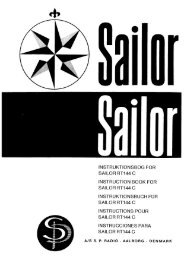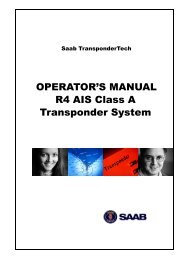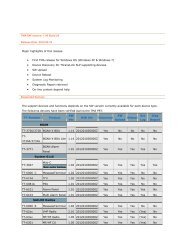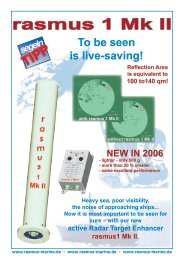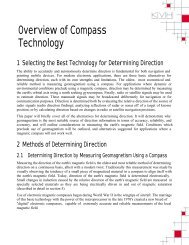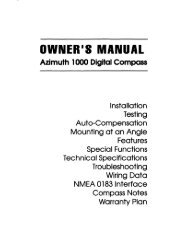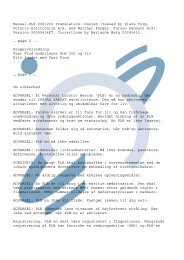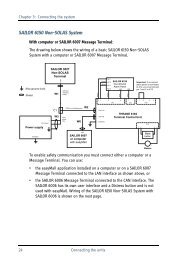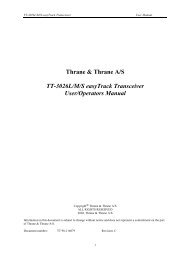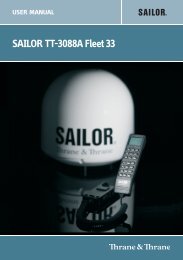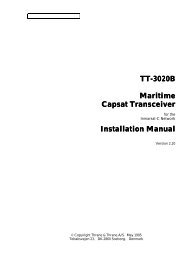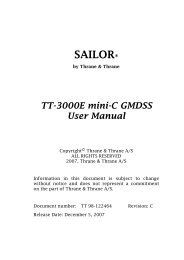user manual rasmus 1 radar signal multiplying ... - Polaris-as.dk
user manual rasmus 1 radar signal multiplying ... - Polaris-as.dk
user manual rasmus 1 radar signal multiplying ... - Polaris-as.dk
Create successful ePaper yourself
Turn your PDF publications into a flip-book with our unique Google optimized e-Paper software.
Introduction<br />
We highly appreciate your confidence in and choice of the Dantronik-Marine <strong>r<strong>as</strong>mus</strong><br />
GmbH product. This User Manual provides essential information related to function,<br />
installation, mounting, servicing, and troubleshooting of your <strong>r<strong>as</strong>mus</strong> 1. Therefore, prior<br />
to use of the instrument, read this Manual thoroughly and then follow it accurately.<br />
<strong>r<strong>as</strong>mus</strong> 1 is designed to resist all and operate reliably in extreme weather conditions.<br />
Safety Precautions<br />
Use the instrument for the intended purpose only, note supply voltage data, and<br />
connect the instrument to an authorized voltage supply only. This is the way to ensure<br />
the reliable and safe operation. Any different way to use the instrument may cause unit<br />
damage and risks during use.<br />
• <strong>r<strong>as</strong>mus</strong> 1 h<strong>as</strong> no wearing parts. So never open the instrument and never<br />
try to repair it by yourself.<br />
• This instrument is designed to incre<strong>as</strong>e your safety. So handle it carefully.<br />
If suspecting that the instrument may be not used further for the intended<br />
purpose, switch it out off and send it back to Dantronik-Marine <strong>r<strong>as</strong>mus</strong><br />
GmbH for inspection.<br />
• On activation, <strong>r<strong>as</strong>mus</strong> 1 sends out <strong>radar</strong> frequencies. Avoid direct<br />
exposure to this. So keep yourself at a safe distance of at le<strong>as</strong>t 0.5 m<br />
apart!<br />
• This is a safety relevant device, which runs a self-test after power on. You<br />
should initiate it on regular b<strong>as</strong>is. (See the self-test description in<br />
paragraph “Setting into Operation”).<br />
Instrument Description<br />
<strong>r<strong>as</strong>mus</strong> 1 is an active, electronic Radar Reflector, an active Radar Target Enhancer,<br />
designed to improve the navigation safety. On receiving a <strong>radar</strong> <strong>signal</strong> when in standby<br />
mode, the instrument is activated automatically and sends back an electronically<br />
amplified echo to the <strong>radar</strong> display screen of the transmitter. On heavy-traffic seaways<br />
and mainly during the dark time and in bad weather conditions such <strong>as</strong> fog, storm, and<br />
heavy rain, <strong>r<strong>as</strong>mus</strong> 1 allows small boats (motorboats, yachts, and rubber boats) to be<br />
reliably detected by ships’ <strong>radar</strong> screens.<br />
Additionally an audio <strong>signal</strong> is integrated to indicate a <strong>radar</strong> <strong>signal</strong> is received – when<br />
switched on- by buzzing sound. This is in particular <strong>as</strong> well recommended for<br />
yachtsmen going on one hand tour <strong>as</strong> for sailing with small crews!<br />
Note: The supply voltage should be within the range of 12 to 24 VDC to ensure<br />
compliance with all specified characteristics and essential technical requirements.<br />
p. 3



